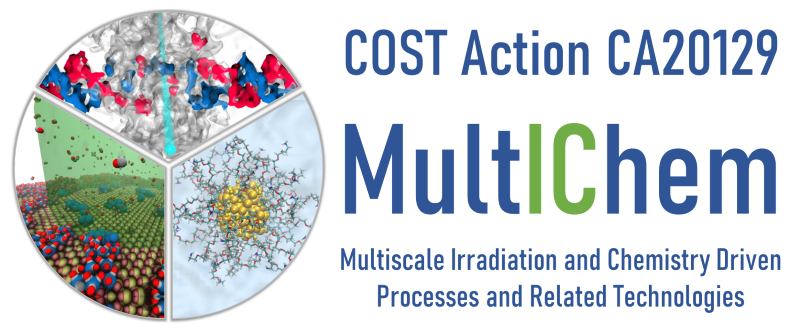Research Coordination objectives:
- To combine and advance experimental, theoretical and computational modelling methods for studying, on a molecular level, irradiation-driven chemistry processes underlying radiation-induced biodamage; radiation-induced formation of nanostructures on surfaces; catalytic and radiosensitising properties of metal-based nanoparticles exposed to radiation. To exploit this knowledge for the development of industrially viable computational tools.
- To establish a comprehensive databank of irradiation-driven chemistry (IDC)-related quantities, e.g. photon, electron and ion interaction cross sections with bio- and organometallic molecules, nanoparticles and nanostructures, chemical reaction rates, diffusion coefficients for different atomic and molecular species, compositions of metal-containing nanostructures grown by focused electron beam induced deposition, etc.
- To develop computational tools based on molecular-level understanding of IDC and multiscale modelling of biodamage phenomena (relative biological effectiveness, DNA damage response, etc.) with the aim of developing the nanodosimetry based dose delivery protocols and their utilization in new-generation treatment planning systems for ion-beam cancer therapy.
- To develop specific computational workflows for multiscale modelling in nanofabrication of nanostructures, nanoparticles and composite materials, as well as molecular-level characterisation of the IDC processes therein. This will enable optimal experimental conditions and better technological control of fabricated nanostructures and materials with enhanced catalytic and radiosensitising properties.
- To disseminate the scientific and technological outcomes of MultIChem to a broader scientific community, policy makers, and the general public.
Capacity Building objectives:
- To establish a pan-European IDC community that will combine advanced theoretical and computational methods with advanced experimental techniques for studying collision- and irradiation-induced processes involving biomolecular systems, nanoparticles and nanostructures, while fostering the development of the existing experimental and theoretical tools beyond the state-of-the-art.
- To accumulate and systematise the knowledge collected by different complementary communities working in the areas related to IDC. To formulate the key research domains of the IDC research field and determine directions for its further development.
- To consolidate efforts of different research communities studying IDC towards technological breakthroughs in the development of novel radiotherapy treatment protocols, nanofabrication methods, as well as novel radiosensitising agents and nanocatalysers.
- To establish a critical mass of scientific knowledge, infrastructure, managerial experience and open communication opportunities to ensure that the MultIChem Consortium remains active and sustainable after the completion of the Action.
